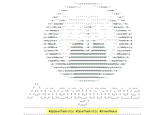Operation Save the Arctic
Confirmed 38,909
Part of a series on Anonymous. [View Related Entries]
Operation Save the Arctic
Part of a series on Anonymous. [View Related Entries]
Background
On June 7th, 2012, Greenpeace launched a major campaign called Save The Arctic[1], which called for the designation of the North Pole as an environmental sanctuary and protested against the international oil companies' plan for drilling in the region. The campaign was announced during the Rio Earth +20 Summit in Brazil with mass pledge of support from more than 100 public figures and celebrities, as well as an elaborately staged viral hoax campaign targeting the corporate image of Shell Oil Company.

Throughout June 2012, the campaign continued to gain momentum and began receiving extensive coverage in the news as a result of the viral hoax, which was largely praised as an effective method to raise the public awareness.
Notable Development
Operation Save The Arctic: Phase I
On June 27th, 2012, international hacktivist collective Anonymous released internal data allegedly obtained from Exxon Mobil Corporation via Pastebin.[2] Dubbed the "Phase I of Operation Save The Arctic," the Anonymous leak operation led by its spokesperson CyberZeist (Twitter handle: @le4ky)[4] exposed 300 e-mail accounts that were linked with Exxon Mobil employees, which were then used by Anonymous members to sign the Greenpeace anti-Arctic drilling petition. The news of the leak was quickly travelled through the grapevines of Twitter, giving rise to the hashtags #OpSaveTheArctic[8] and #SaveTheArctic.[9]
|
|
|
Greenpeace's Response
Following the news media coverage of the leak, Greenpeace responded to the Anonymous operation with a welcoming tweet[5] on June 29th.
The Arctic receives #anonymous support. Arctic oil drillers Exxon hacked in operation #OPSaveTheArctic #SaveTheArctic cyberwarnews.info/2012/06/27/oil…
— Greenpeace (@Greenpeace) June 29, 2012
That same day, cybersecurity news site Cyber War Zone uploaded a YouTube video titled "Official Anonymous #SaveTheArtic – Phase 1 and 2"[6] along with a blog post[7] instructing its readers how to help.
Operation Save The Arctic: Phase II
On July 16th, Anonymous hackers once again led by CyberZeist published an additional volume of more than 1,000 e-mail accounts via Pastebin[3] that were taken from multinational oil companies Shell, Exxon Mobil, British Petroleum and Russian companies Gazprom and Rosneft. Furthermore, CyberZeist admitted in the Pastebin document that some of the data released earlier in June had been re-appropriated by third parties for e-mail phishing schemes. According to the information security news site NovaInfoSec[16], the second installment of data dump comprised of 317 e-mails and their MD5 hashed passwords obtained during Phase I of the operation, as well as 724 additional e-mails and their passwords retrieved from Phase II.

The D.C. beltway news site further speculated that while most of the information was still encrypted upon release, it had been publicly released in the hope that other volunteers and hacktivists will join the efforts in deciphering the details. The second wave of data dump was covered by a wide range of online news publications like Examiner[10][11] and The Daily Dot[13], as well as tech news blogs WebProNews[12], Wired[14] and The Next Web[15] among others.
Search interest
External References
[1] Greenpeace – Save The Arctic
[2] Pastebin – #SaveTheArctic – Phase I
[3] Pastebin – #SaveTheArctic – Phase II – Mass Hack
[4] Twitter – @CyberZeist
[5] Twitter – @Greenpeace's Status Update
[6] YouTube – Official Anonymous #SaveTheArtic – Phase 1 and 2
[7] Cyber War News – OIL Giant Exxon Mobil Hacked, Data Leaked By @Le4ky
[8] Twitter – #OpSaveTheArctic
[9] Twitter – #SaveTheArctic
[10] Examiner – Greenpeace welcomes Anonymous after Exxon Mobil hack
[11] Examiner – Anonymous hits big oil: Operation Save the Arctic continues
[12] WebProNews – Anonymous Targets Oil Companies in #OpSaveTheArctic
[13] Daily Dot – Anonymous hits oil companies, leaks 1,000 employee logins
[14] The Next Web – Anonymous hackers target oil industry giants, more than 1,000 email credentials exposed
[15] Wired – Oil Companies Spring a Leak, Courtesy of Anonymous
[16] NovaInfoSec – More Password Hashes to Crack – The Oil Company Edition
Recent Videos
There are no videos currently available.
Recent Images 4 total
Share Pin
Related Entries 29 total
Recent Images 4 total
Recent Videos 0 total
There are no recent videos.





Comments ( 29 )
Sorry, but you must activate your account to post a comment.
Please check your email for your activation code.